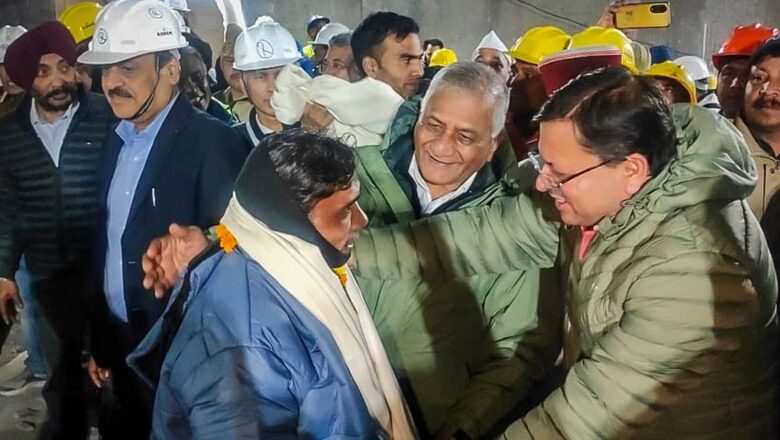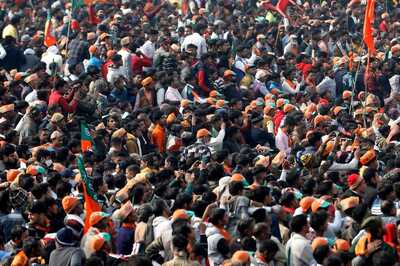
views
It was hard not to feel a lump in one’s throat when seeing the relieved, smiling faces of the 41 construction workers trapped in a collapsed mine finally emerge from the equivalent of a ‘rathole’. For 17 suspenseful days fickle fate had forced their incarceration in a tunnel being constructed in sylvan Uttarkashi.
Many had warned that Mother Nature would not endure the unrelenting exploitation of her land in the name of progress and development. That in time she would rebel and the repercussions would be forbidding. The warning signs were already there. The mountains in Uttarakhand had been splitting and subsiding at an alarming rate.
Silkyara, in fragile Uttarakhand, was only the latest hotbed where beastly machines with serrated proboscis were boring through the Earth’s flesh. The quest to build the tunnel was as usual driven by humankind’s need to make life easier for its people, never mind the cost or the means. Something had to give way and it did. Nature had had enough. The tunnel caved-in entrapping the workers in a man-made concrete prison. In time an audit will determine where exactly the engineers overplayed their hand and what red flags were ignored.
For days hope and despair rose and dissipated in an unending rhythm as the original transgressors – super heavy drilling-turned-rescue machines inched forward only to be thwarted by the impregnable innards of the unrepentant mountain.
But in the end human labour triumphed courtesy of an improbable role reversal. The failing machine gave way to the plucky ingenuity of man – even in this age when machines and tech are predicted to eclipse their human makers.
Finally, as a newspaper reports, ‘India moved the mountain.’ A billion prayers, so to speak, were answered and hopefully some lessons learnt.
But beyond the clever word play lies a greater story.
The story of a new emerging Bharat shaped by ‘diversity in unity’.
There’s no doubt that the other phrase ‘unity in diversity,’ coined by the greats of the pre-independence era, has bound us together into a composite whole. It is said that this phrase made a nation out of our civilization. It was a reminder to our disparate selves that if we look beyond our immediate creed, caste and community we can coexist in a plural paradise.
Thanks to our ‘unity in diversity’ India is often thought of as a miracle on Earth. ‘Incredible India’ is a living, breathing, miniaturized version of the other heaving beacon of syncopated multiplicity: the Earth. The primordial nurturer.
But while ‘unity in diversity’ has given us a sense of nationhood and purpose to be proud of, it has been slow to create the circumstances for that promised ‘tryst with destiny.’ Too many of us have been let down by the organs of the state that often haven’t worked in unison to do justice to the nation we gave ourselves.
Rather, to build a robust state that works seamlessly, like a well drilled phalanx of soldiers, we need all the diverse parts to come together. In sharp contrast to ‘unity in diversity,’ ‘diversity in unity’ has thus proven harder to orchestrate. Had we been arguably able to get the diverse instruments of the state to move along the planned path, the state may have delivered the vast multitude of Indians out of their abjectness.
But things are changing, and India is finally getting its act together. Different moving parts of the state are increasingly combining to deliver success.
In Silkyara, for instance, this was most evident. Here a plethora of Central and Uttarakhand government agencies with different working cultures combined beautifully to snatch triumph from the jaws of disaster.
It was fortunate that the state recognized early on that it would take immense co-ordination and communication over its length and breadth to save these unheralded heroes.
Today, because of the emphasis of the state, we at least know the names of those who survived this disaster unlike the anonymous millions who silently toil to build India.
History of India, however, is riddled with false starts. The state often loses sight of the lessons it ought to have learnt from setbacks and disasters because it gets distracted by fripperies: credit hogging and self-congratulation.
While Uttarakhand has every right to congratulate itself, one hopes the state internalizes the key learnings from Silkyara so that it becomes conditioned to deliver every day not just in moments of disaster.
Such a result would mean that we may never have to see one our children disappear down manholes or commuters swallowed up by potholes. We may even end up breathing clearer air and drinking cleaner water. Such a life would certainly be worth living.




















Comments
0 comment